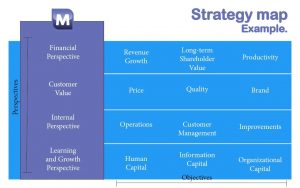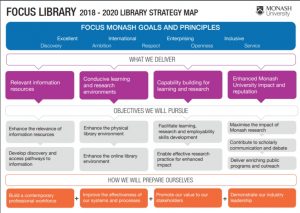
7 Qualities of an Effective Nonprofit Executive Director
October 20, 2020
Horror Stories: Monster Tales from a Strategic Planner
October 20, 2020Goodbye Business Plan. Hello Strategy Map! [with Strategy Map Examples]

Strategy Maps in 4 Steps:
- Strategy Maps are a one-page visual overview of your organizational perspectives and objectives to help explain and drive strategy to all levels of the organization.
- Developed by Harvard Professors Robert S. Kaplan and David P. Norton
- Helps with strategy execution and revenue growth
- The process starts with a one-page document
What Exactly Is a Strategy Map?
Strategy mapping was created in the 90s by Harvard Professors Robert S. Kaplan and David P. Norton. They also created the balanced scorecard which has a primary focus of being a feedback tool. The balanced scorecard methodology includes strategy mapping, the most essential and important step of the two.
A business strategy should be defined by more than just traditional balance sheets and income statements – that’s where a strategy map comes in!
Strategy mapping is a tool to show corporate stakeholders the overall business strategy from an internal and external perspective. This helps align their organization to meet customer expectations. It is meant to give a more complete perspective that includes financial and non-financial factors including learning and growth.
By using this method, a company will develop a better agile internal business process and execute its strategic priorities. It’s a way for an organization to identify gaps within the strategy structure while leading with their mission, vision, and values. If your business cannot display its strategy on one page it shows that the business hasn’t developed and understood the strategy enough. Many businesses can explain their strategy on multiple pages, but being able to digest a complex strategy in a simple one-page format helps the organization understand what they are trying to do. The map is a simple document, but essentially one of the most important in your strategy execution.
“If you can not measure it, you can not improve it.”
– Kaplan
What a Strategy Map Will Help you Achieve?
Mapping out your strategy will help you understand your business plan, achieve strategy execution, and help generate revenue growth. Simply put, if you don’t have one and you’re working towards a big picture, will you actually get there? By first creating a strategy map you set the guidelines for your entire strategy to align with your mission, vision, and value statements. If you haven’t touched on those, we recommend defining them before advancing to your strategy map.
Free Mission, vision, and value statement guides from MPOWR Strategy Executive, Andrea Gibbs:
The Process
Even if you have a strategy software to track your strategy a business should still create a strategy map. Creating one is an easy process, we recommend starting in a Word or Google Document. The process starts with a one-page layout of your business perspectives. Your business perspectives should align with your mission, vision, and values of your strategy and typically touch on the following strategy themes and perspectives, but if these perspectives don’t fit the organization they can be adapted:
- Financial Perspective
- Customer Value
- Internal Perspective
- Learning and Growth Perspective
Within the perspectives, you will then choose strategic objectives for your business that tie into your overarching strategy. If you are just starting out with your strategy map for the first time, start with fewer objectives. It’s important not to dilute your overall strategy; the goal is to keep your map concise and get it on one page.
Building Your Map
When building your map, have fun with it! Maps should also be branded and become part of your new employee onboarding process. It’s important to include alignment within your organization so all stakeholders, employees included, can see where the company is heading and what their own role is within your strategy map.
Having one will help eliminate gaps by giving a clear view of where your organization is going with short-term and long-term strategic goals. It will also help manage KPI’s in the future by tying them back to these initial strategic initiatives.
Here are some basic tips when creating your new map:
- The map is typically outlined by shapes to help distinguish between an object (circles, squares, etc.).
- On one side list your overarching perspectives (Learning and Growth, financial, customer, internal, etc.)
- Next, you will list your objectives that tie into those perspectives on the right-hand side
- See the strategic mapping template below, which uses bold colors to distinguish between perspectives and objectives
Strategy Map Example:

The perspectives are outlined on the left in purple which are the key drivers for what will bring long-term value to stakeholders. The objectives then tie into the perspectives on each line. The rule of thumb is to have at least one financial objective along with at least seven non-financial objectives.
With the map, the financial perspective will help tie non-financial objectives into a long-term strategy. The above example outlines one perspective per line with similar objectives, but feel free to outline your map with your own colors or shapes to help you define your perspectives and objectives.
“The stakeholder approach to performance measurement starts by defining objectives for what each stakeholder group expects from the corporation and how each group contributes to the success of the corporation”
– Kaplan & Norton
By outlining the themes and perspectives in your visual map a business will have a clearer view of what they need to write for the business objectives to accomplish stakeholder value. Keeping perspectives on the key four themes will help an organization hone in on a tangible strategy map that businesses will actually execute.
More Strategy Mapping Examples:
It is best to have a visual representation of your broader strategic plan. With a strategic management tool like MPOWR Envision, you can visually see your strategy in real-time with our strategic planning software. This lets your internal stakeholders know right away whether your strategic themes are healthy or need attention to meet your business goals. Think of it as modern-day strategy management!

The below maps are other great examples of for-profit and not-for-profit strategy mapping! Don’t get discouraged if you have a hard time laying out your map. Start with the perspectives and work your way through the objectives with your teams in a list format and then transfer into a map setting in a document or other software.

(Source: Kaplan and Norton)
The above strategy map was developed by Kaplan and Norton, the strategy mapping founders themselves. It outlines perspectives, objectives, and the flow from learning and growth through financial perspectives. This is a great example of utilizing different shapes throughout your map to define the different flows between perspectives and objectives within your strategy.

This example from Monash University is another strategy map example but from a non-profit perspective. Whether your focus is on a for-profit or not-for-profit organization, you will gain great value by creating a map to share within your organization.
The key take-away with your strategy map is that it will look different depending on how the organization wants to layout their map with perspectives and objectives. The document could be extremely creative or simple and to the point. As long as the organization has clearly defined their strategy with its mission, vision, and values and using those statements as a guide, there isn’t a wrong way to start creating a map. Focus on the four main perspectives and then outline the objectives.
Did you know that MPOWR leaders have years of experience in Strategy Mapping along with various other strategy development methods and tools? For fast-paced companies, we understand time and resources are limited, so MPOWR Envision offers our expert team to yours! Book a consultation with one of our strategy executives today to start executing and measuring results!
Jeff
 He is a former MBA program director and professor emeritus. He’s consulted for companies in leadership and strategy and is a partner with an international affiliate. Jeff earned his MBA from Eastern Illinois University.
He is a former MBA program director and professor emeritus. He’s consulted for companies in leadership and strategy and is a partner with an international affiliate. Jeff earned his MBA from Eastern Illinois University.
Jeff has trained and consulted various size organizations in a wide variety of fields. He has even attended training from the Palladium group, which was founded by Kaplan and Norton.—making him a go-to for your strategy mapping questions.
Andrea
 She is a master of expertise in helping companies define their strategies and actually have them execute their goals. Andrea has helped numerous companies by teaching and training others in organizational strategy, implementation, and communication. She has helped countless for-profit and not-for-profit organizations as well as numerous MBA students in her classroom. She also created a free 30-minute consulting brief to help non-profits and for-profit companies execute.
She is a master of expertise in helping companies define their strategies and actually have them execute their goals. Andrea has helped numerous companies by teaching and training others in organizational strategy, implementation, and communication. She has helped countless for-profit and not-for-profit organizations as well as numerous MBA students in her classroom. She also created a free 30-minute consulting brief to help non-profits and for-profit companies execute.
![Goodbye Business Plan. Hello Strategy Map! [with Strategy Map Examples]](/wp-content/uploads/2022/10/getlogo.png)


